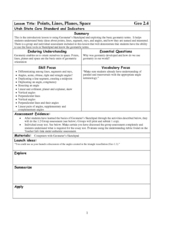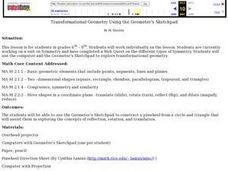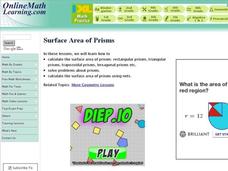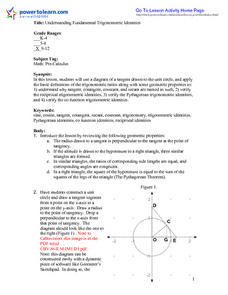Curated OER
Points, Lines, Planes, and Space
In this points, lines, planes, and space worksheet, learners solve word problems dealing with points, lines, planes, and space. Students complete 20 individual problems and 20 group problems.
Curated OER
Geo Jammin By Design: Coordinated
Young scholars watch the teacher draw on the chalkboard and try to determine the form being drawn. They use questions to determine Quadrant #1 of a coordinate plane.
Curated OER
Ge-Oh Boy, Oh Boy
Young scholars listen to the book, Sam Johnson and the Blue Ribbon Quilt and discuss the art of quilting. They examine various symmetrical sewing designs, and identify reflection pieces, slides, and flips.
Curated OER
Manipulative Mania
Students explore tangram vocabulary and tangram designs, creating an art design that contains various geometric parts. They complete a checklist titled, Important Thing About a Quilt Design.
Curated OER
Quilting Geometry
Study geometry through the concept of quilt design. High schoolers examine the geometric shapes in various quilts and then create their own quilts using geometric shapes that fit together. In the end, they write a paragraph to describe...
Curated OER
Transformational Geometry Using the Geometer's Sketchpad
Students complete a webquest on the various types of symmetry. Using a computer, they explore the concepts of transformational geometry and identify points, segments, lines and planes. They experiment with the rotation of a quadrilateral...
Curated OER
Making and Describing Shapes
Explore the concept of creating and describing 2D and 3D shapes. Using geometry your scholars will describe the attributes of shapes and their properties. They explore and discover what happens when you combine shapes and then take...
Curated OER
Angle Exploration and Classification
Students compare and contrast angles and identify them as acute, obtuse, right, or straight angles. They create rays and angles using uncooked spaghetti, read and discuss key vocabulary terms, and complete a variety of geometry worksheets.
Curated OER
What Shape am I?
Young scholars analyze characteristics of geometric shapes. They find shapes in their environment, and communicate why it is like the shape of their choice and not like another shape.
Curated OER
Shaping Up with Nature at Black Bayou Lake
Students visit a local lake refuge and identify shapes they find in nature. They take pictures of the various shapes and use KidPix to draw shapes around the shapes in the pictures. They watch a slideshow of all the shapes found by their...
Curated OER
Rep Tiles
Third graders use pattern blocks of one shape at a time to try to create a similar shape. They compare the perimeter of the new figure with the perimeter of the original shape and look for a pattern. Students use the pattern to predict...
Curated OER
What do two-dimensional tessellations look like? Where in art can they be found?
Students explore the world of art and culture, including the works of M.C. Escher. They identify and create original tessellations. Students use a wealth of interactive multimedia applications. They explore the artistic representations...
Texas Instruments
Construction Regular Polygons
Learners investigate the process necessary to construct regular polygons. They explore the degree measures of the angles in a regular polygon. Using this information and technology in the form of Cabri Jr., your pupils will construct...
Curated OER
Surface Area of Prism
Tenth graders are provided instructions, including a video, on calculating the surface area of a prism. The one-page interactive worksheet contains two worked questions. Answers are included.
Curated OER
Understanding Fundamental Trigonometric Identities
High schoolers are introduced to the basic trigonometric identities. Using a diagram, they discover why the parts of the unit circle as named as they are and use equations to finalize the Pythagorean trigonometric identities. They also...
Curated OER
Area of Complex Figures
Fifth graders use formulas for calculating areas of squares and rectangles to find area of complex figure, compare their own ideas with their classmates' ideas, and recognize that there are multiple methods for finding area of complex...
Curated OER
Investigating Nets and Polyhedra
Fifth graders create a net for a given polyhedron. They determine the corresponding polyhedron for a given net. Students investigate several polyhedra (cube, tetrahedron, and one of their choosing) and their corresponding nets. They...
Curated OER
It's a 3-D World Out There!
Young scholars construct polygons. They identify attributes of three-dimensional shapes. Students name common three-dimensional shapes. They draw three-dimensional shapes, and sort three-dimensional shapes. Young scholars use K'NEX...
Curated OER
ExplorA-Pond:2nd Grade Shapes & Fractions
Second graders, in groups, using a map, drawing or aerial view of a pond, represent the shape of the pond using simple geometric shapes or fractions of those shapes.
Curated OER
Plain Figures And Measuring Figures
Seventh graders investigate the mathematical concept of a sector. They apply the concept to an example problem and then move into a more complex application. They find the area of the side of a cone. This is done as students calculate...
Other
Nearpod: Congruent Triangles & Similarity
For this lesson on congruent triangles, students explore how to use postulates to identify if triangles are congruent by SSS, SAS, ASA, and AAS.
Cuemath
Cuemath: Congruent Triangles
Explore the world of congruent triangles in this mini-lesson. Provides a definition and examples that help with understanding their properties. Includes a short video and practice questions with answers.
CK-12 Foundation
Ck 12: Geometry: Congruent Triangles
[Free Registration/Login may be required to access all resource tools.] This concept teaches students what it means for two triangles to be congruent and how to identify corresponding parts of congruent triangles. Students examine guided...
CK-12 Foundation
Ck 12: Interactive Geometry: 3.5 Applications of Congruent Triangles
Learn how two triangles are congruent if and only if their corresponding sides and corresponding angles are congruent.























